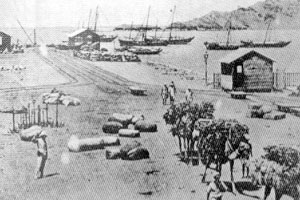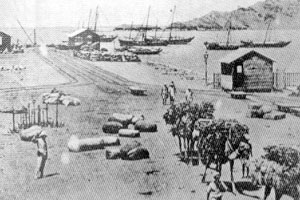
Remembering Aden During (1839 – 1967) [Archives:2001/07/Reportage]
February 12 2001
Ridhwan Al-Saqqaf
Aden Bureau Chief
Yemen Times
In his history book titled “Tarikh Thaghrat Aden, historian Bin Makhramah describes ancient Aden by saying that “Upon killing his brother Abel, Cain was afraid of his father Adam so he escaped from India to Aden and settled down in Seira mountain. When he felt desolate due to his banishment from the settled country, Satan showed up, trying to entertain him with some form of entertainment . It is said that there was no sea separating Aden and Socotra. They were both as one land until Dhul-Qarnain came on board a ship to the place and dug up a gulf in the sea and stood on the Bab al-Mandab mountain as Aden was surrounded by water.
Britons’ Control over Aden:
When Aden was captured by the Britons, the British government had been trying to tighten its grip over Aden for 15 years, ruling out the possibility of any attacks from any neighboring tribes. Captain Hans was the first political resident in Aden.
In 1848, trade and a construction drive helped the economy to boom in Aden. The British government started creating job opportunities for the Britons residing in Aden. The focus was on the town itself and the neighboring areas.
In 1855, a truce was announced between the Sultan al-Fadli and the British government. In 1857, there was a clear development in relations between the Britons on the one hand and the Abadel on the other, to the extent that Sultan Fadl bin Muhsen al-Abdali requested the British government to protect him from the Turks when the latter captured some of his lands in 1873.

In March 1867, an agreement was signed between the political resident in Aden Mr. Asidoliam and Fadl bin Muhsen, Sultan of Lahj, to dig up a channel supplying Aden city with water from wells in Sheikh Othman, that is, from the North to the South as far as a camp located nearby Hadid mountain. The channel still exists until the present time. The channel was dug by the Britons and protected by the Sultan in exchange for some money that he received on a regular basis. Water used to flow to large water containers for the British camps use of the British camps.
During 1863-1867 and when colonel Meiroyders, political resident, was on Aden, military barracks increased visibly. A lighthouse to show directions for ships and colony secretariat were also established. A military bridge was also built above Aden gate.
The British Policy in Aden:
Controlling Aden was not the end of the British greed in the south of Arab Peninsula. Their control of Aden was the starting point of an expanding campaign to ensure their control over the East African Horn. Building up a strong army to protect it from any attacks by Arabs surrounding it, was also given a top priority at the time. The invasion of Aden cost the British government a lot; 1000 riyals on a daily basis used to be spent for protection, another 1,000 riyals were spent on other issues, 7800 riyals were spent on salaries for nine Emirs and their men when every Emir used to receive 400 riyals except for the Sultan of Lahj who used to receive much more.
Aden city after Suez Canal Inauguration:
After the inauguration of al-Swiss canal, the trade drive boosted in al-Tawahi port. The port was then expanded to provide ships with coal and other provisions. A good number of new companies and rich families maintained direct contacts and strong relations with British officials. Such atmosphere enticed many employees from the neighboring areas to come and work there. It also buoyed up the transferring of goods from the port of Aden to other ports and vise versa. Coffee and gum trade was of the most outstanding goods, after being transferred from Makka Port to Aden port.
Population Growth in Aden:
After the British colonization, Mr. Hans carried out a census of those living in Aden and found that they were not exceeding 600: 250 Jews, 40 Indians, and some from Africa. Soon, it was found out that the census was quite inaccurate as it was conducted immediately after the colonization when majority of the people were afraid of the British garrison.
Five months later, another census was conducted making them 2855. In 1850, the number of people living in Aden reached 9800. This was a testimony of the rapid population growth. In 1891, the population run to 40,926. This rapid growth was not approved by the British government at the time. As a result the “deportation policy” was applied by the British government. Many Arabs and many residents of al-Mua’ala and al-Tawahi were driven out to Sheikh Othman.
Aden During the First World War:
During 1839-1914, Aden witnessed many political as well as social changes. The British government pulled all stops to have a tight grip and firm control over the area in a way that served its expansion plans in the South and East of Yemen. It signed many treaties and protection agreements with many tribes’ sheikhs. It also supported some development projects in some areas. In 1905, it supported a railway project connecting Aden to Lahj. It helped Sultans to establish local forces for protection. In 1906, the British government ceased its support for the railway, marking a new turn in its policy.
After defining the demarcation between Turks and the Britons in Aden, the 1st world war broke out on 15. November 1914. Turkish forces supported Germany and waged war on Britain and France, specially after attacking the Ottoman fleet in the red sea which made this place a conflicting area for the two sides. The British forces were in danger, especially as Aden was close to the Ottoman garrisons in Yemen.
When the war started, it was bound that the two forces would clash in the Yemeni land. However, war between these forces in the Yemeni lands did not last for long. During the war Aden residents used to sympathize with the Ottoman forces as they were Muslims fighting against disbelivers. With the cooperation of some Sheikhs of tribes, Turks were able to capture some British protectorates and controlled Lahj. Then, these forces advanced towards al-Dale’e and Yafe’e. They reached Sheikh Othman. However they pulled back and Sheikh Othman used to separate the two forces. British felt the bitterness of the defeat in Yemen. The political resident in Aden was dismissed as a result. Since then, the British government in London was in charge of handling issues in Aden.
Aden and the Indian Style:
Since 1937 the Indian style was dominating Aden, especially during the period when Aden was affiliate to the British administration in India. The Indian style was visible in constructions, food and ways of life in general. This had made people raise the motto “Aden is an Arab City” and that the future of its people was with Arabs and not with Indians. They called for demolishing the Indian life style in the city and to restore Islamic and Arab style. They exercised pressure on the British government in religious ceremonies and festivals taking place. This has made the social, racial discriminations appear visibly between Yemeni, Arabs and Indian residents. Clashes between them were also predestined to happen and was supported by the British government. Indians started to have a clear awareness that they were taken advantage by the Britons, especially when Aden was connected with the British colonies instead of the Indian administration in 1937. The Indian currency continued to be used though until 1951 when the shilling, the African currency, replaced it. Ever since Aden was affiliated with the British Crown. It had its own legal position and its own ruler appointed by the British government. It was prepared as a marine site and a connection point with the Eastern and western protectorates.
Life started to change and trade boomed dramatically in 1942, especially when the port of Aden became a major port to supply ships with oils instead of coal.
The first electric power station was established in Hujaif to provide more facilities for the port. Water was connected through pipes to special containers to provide ships with water. Roads were paved as cars started to be used for transportation instead of carts.
——
[archive-e:07-v:2001-y:2001-d:2001-02-12-p:./2001/iss07/report.htm]


